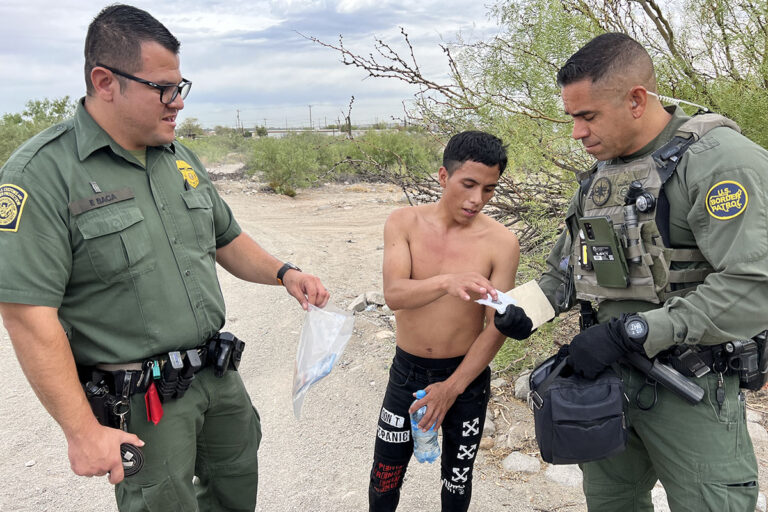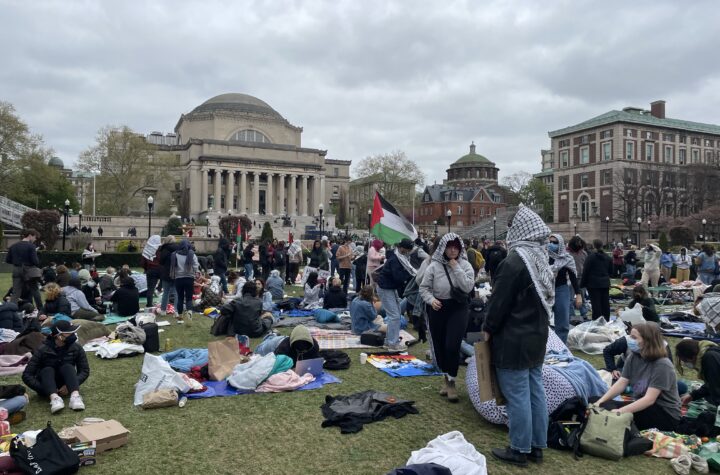
GUATEMALAN | Migrant detained by Border Patrol. (Photo/Morgan Smith)
TOUR WITH THE BORDER PATROL AT THE SOUTH BORDER
Morgan Smith
Haga click aquí para leer la versión en español
It was 6 AM, still semi dark as I waited by the Sunland Park Police Station for the Border Patrol agents. The sky was overcast and the temperature only 82 degrees. The day before it had been 109 degrees when I delivered food to several shelters in Juárez. Soon Agents Fidel Baca, Sean Coffey and Marcia Finnegan arrived. Baca, a 14-year veteran would be our driver.
The first stop would be near the base of Monte Cristo Rey where other agents had detained a woman who initially claimed she lived in Anapra but then admitted she was from Torreón, Mexico. She had fallen while descending Monte Cristo Rey, had a small cut near her mouth and was taken to medical care.
On the ridgeline way above us, the agents could see a group of maybe ten migrants who, were waiting for a chance to come down the mountain and enter the US. A helicopter hovered nearby. “It’s a waiting game,” Baca says. This area along the base of the mountain and the area several miles to the west where a border wall separates Sunand Park, New Mexico from Anapra, Mexico are two prime crossing points.
I know the Sunland Park-Anapra area well because for years I’ve been giving the families who live there dollar bills in return for photographs. I also once participated in building a house for a family in Anapra with St. Bede’s Episcopal Church from Santa Fe. Unlike the Border Patrol agents who are not allowed to go into Mexico, I have been in Anapra many times and am well aware of the extreme poverty there.
Baca tells me what I’ve heard from other agents and what seems obvious. Some of the Anapra residents let migrants stay in their homes while awaiting an opportunity to try to cross. Others – kids perhaps – act as lookouts. Victor is one of the older kids who come to the wall to be photographed. Once for an extra dollar, he showed me how he could scale the wall.
Up he went like a little monkey. Is he a lookout? What are the other options for kids like him, for these desperate families? So far this fiscal year, there have been 347,000 apprehensions in the El Paso area. There have been 114 deaths, 44 heat-related, 394 rescues, 52 heat-related. We now find a man from Guatemala who has injured his leg descending the mountain.
He writes his name down for me. It looks like Mayno Agailos but his handwriting is as bad as mine. He was detained by a young Sunland Park police officer who says he loves his work. I tell Baca that the Border Patrol should recruit him and he agrees. Agent Finnegan is from Illinois and has been in the Border Patrol three and a half years.
There are fewer women in the Border Patrol than in the US Marines, Baca says. “The fierce five percent,” he calls them. He says that they need more women, they need the different perspective and experience they can bring but recruiting is a slow process. Finnegan says that her friends and family members discouraged her from joining the Border Patrol but she’s glad she did.
Then we head to downtown El Paso. There had been a rumor that today would be a “free day,” one where anyone could cross without consequences so a surge was expected but we spotted no one as we drove along the US side of the border and looked out into Juárez. I noted far fewer Texas National Guard vehicles along the riverbank but huge rolls of concertina wire.
The barren riverbank where hundreds of Venezuelans had camped while waiting for Title 42 to be lifted was empty. Then it was back to the Monte Cristo Rey area. The helicopter was still hovering above. We soon spotted a young man from Ecuador hiding under some bushes. He sat quietly, took the laces out of his boots, then handed over his documents and a few crisp looking twenty dollar bills. He seemed resigned to his detention; maybe this wasn’t the first time.
There were about 8 agents gathered near him. One agent named Soltero said that he had climbed to the top of Monte Cristo Rey the preceding Saturday. Looking up the steep slope of shattered rock and imagining the heat, I thought back to my younger days as an avid mountain climber back in Colorado. This would be a huge ordeal.

ECUADORIAN | Migrant delivers his identity documents to US agents.
But what about the migrants who pay coyotes or cartels thousands of dollars – an average of $7,000 each, I’m told – and then have to descend this mountain like the woman from Torreón or these two men from Guatemala and Ecuador? And what happens if they do make a safe descent and end up in a stash house where the coyotes then demand a second payment?
Agent Baca says that the days of smuggling marijuana across the border are long gone. Now the money is in humans. The average annual income in Honduras is about $4,500. Imagine having to come up with $7.000. I’m a Thomas Friedman fan. He says that, “We need a high wall with a big gate on our southern border.”
These agents are our wall and I have great respect for them. They are much more effective than the wall separating Anapra and Sunland Park, for example. A few months earlier I saw a coyote go over that wall with an aluminum ladder in just seconds. To maintain that high wall, we’re going to need more agents, a difficult task given that there are now an increasing number of retirements, Baca says.
And Friedman’s “big gate” is very unclear. There are thousands of men coming north not for US residency but for work and there are thousands of unfilled jobs all across the US where they be in agriculture, construction, the restaurant business. We seem unable to match these two issues, a task that would seem to be simple and without controversy and that would also ease the numbers we have to deal with.
The asylum issue is a tougher one. Through sheer neglect, we’ve failed to maintain a judicial system adequate to handle these thousands of cases. The result is a huge backlog that is a continuing source of political turmoil. This situation will not get easier. Look at the political chaos in much of Latin America. Nicaragua, once the safest country in Central America has been devastated by the Daniel Ortega regime, a quarter of the population of oil-rich Venezuela has fled; a candidate for President in Ecuador has just been assassinated.
Add to that the growing threat of climate change, the destruction of crops, and the inability to find relief from staggeringly high temperatures.mWith the 2024 elections nearing, we can expect politics rather than reason and progress. It’s reassuring, however, to see the Border Patrol at work. They’re carrying out the Thomas Friedman concept of a “high wall” and they’re doing it with efficiency and humanity.
I was honored to be able to spend the morning with them.
You may also like:
Oaxacan Mezcalero Masters arrive at “Amor a la Mexicana”
Third grade Hispanics did not reach proficiency level in language
Celebrating cultural diversity in Aurora






otras noticias
COVID-19 Affected Individuals Live with its Effects
The gorillas of AMLO
Celebrating the Board of Directors (2024-2025) of the COHCC.